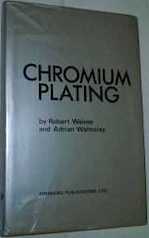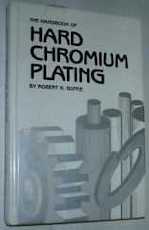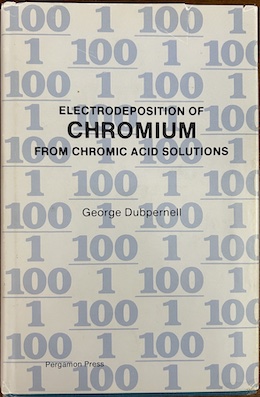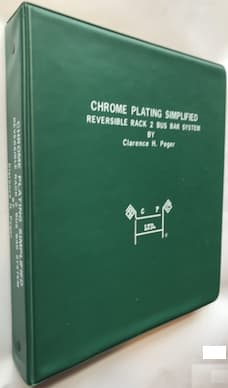
-----
Minimizing iron contamination in a hard chrome plating bath
"HEEF 25" - proprietary name for a chrome plating process, meaning High Efficiency Etch-Free, up to 25% efficient. Efficiency is the measure of what portion of the applied current actually deposits metal (see our intro to Faraday's Law). Chrome plating is notoriously inefficient.
Q. Hi all,
I need more information about the effects of iron contamination in a chrome solution (HEEF 25).
1. What will the affects on the process be?
2. Is there a method to remove the iron out of the solution?
3. At what maximum PPM levels will the solution be useless?
Thanks,
Neville YoungAutomotive Component Supplier - Cape Town, Western Cape, South Africa
2003
A. Hi Neville,
HEEF 25 is a proprietary system, so the vendor--who knows what those proprietary ingredients are--is probably better positioned to help you.
Good luck,

Ted Mooney, P.E.
Striving to live Aloha
finishing.com - Pine Beach, New Jersey
Ted is available for instant help
or longer-term assistance.
A. There is HEEF 25, European HEEF 25 and HEEF 25 substitutes. They are not the same. The manufacturer of the product can tell you what the technical limits are. As far as iron contamination, I used a ceramic porous pot which took out the trash metals and kept the trivalent in check. We plated ID's so the formation of trivalent is a given, regardless of what you do.
James Watts- Navarre, Florida
Q. Hi there,
As part of a grad course I have to help a local company produce a pollution prevention strategy for their hard chrome plating process. Their main difficulty is dealing with the iron contamination in the chromic acid baths; they've installed porous pot/ion exchange treatment systems in the past, and found the costs/trouble to outweigh the advantages.
SO ... does anyone have any experience in actually reducing iron buildup from the start, rather than removing what ends up in the bath? I've been looking into strategies such as using a HEEF (high efficiency, etching free) chrome source, or reducing the reverse etching time, or perhaps having them install a separate tank in which to do the R.E. - can anyone recommend/poke holes in these tactics? Any suggestions for things that have worked in your particular facility? FYI, here are some of the operating conditions of the current baths, if this helps: current = 1800A, voltage = 6-12V, temp = 65 °C, [Cr] ~ 125,000 mg/L, R.E. time = 10 seconds, tanks get refilled when [Fe] > 11g/L
Thanks!
Student, University of Guelph - Guelph, Ontario, Canada
2007
for Shops, Specifiers, & Engineers

by Weiner & Walmsley (1980)
avail from eBay, AbeBooks, or Amazon

by Robert K. Guffie (1986)
avail from AbeBooks, or Amazon

avail from eBay, AbeBooks, or Amazon
"Hard chromium plating: A Handbook of Modern Practice"
by John David Greenwood (1971)
avail from eBay

very rarely avail from Amazon
but copies are available in a few libraries)
"A Chromium Plating Bath With The Fluoride Ion"
by Alfred Perlenfein (2013)
avail from eBay, AbeBooks
(as an Amazon Associate & eBay Partner, we earn from qualifying purchases)
A. Yes, Joel, doing the reverse etching in a separate fluoride-free chrome plating solution tank is a feasible alternative that is in practice in some shops.

Ted Mooney, P.E.
Striving to live Aloha
finishing.com - Pine Beach, New Jersey
Ted is available for instant help
or longer-term assistance.
A. I ran HEEF 25 tanks with a porous pot and had no problem with iron. Since I do not know who made the pot [that you are speaking of] and how well they followed instructions, I cannot understand why they had "problems" with it.
The inner pot does need to be emptied several times (every couple of days) when you start with a high iron content, but this only takes a few minutes. It is messy, but so is chrome plating. As the tank is cleaned up, the duty cycle can stretch out to over a week. A chrome tank costs too much to dump unless absolutely mandatory, so porous pot treatment is very cost effective.
- Navarre, Florida
Q. Joel did you manage to sort your high iron out -- if so, how, thanks.
I've got two tanks with very high contamination levels causing major headaches. We can't afford to dump the old chrome and start again so I've decided to keep topping my larger tank with solution from the smaller tank and add chrome to the small tank it will take time but hoping in the end I will be topping it up with good quality solution and it should lower iron level in both tanks without the expense. Do you think that would work thanks.
Regards steve
Shop manager - Uk
December 2, 2021
Readers are welcome to browse this site anonymously!
-- but its main purpose is worldwide camaraderie through sharing,
so readers wanting that might not engage with anonymous posters.
A. Hi Steve. We can try to alert Joel to your question but his visit was a long time ago so his e-mail probably won't work.
A porous pot will reduce iron contamination but you would need to find out if Hard chrome Plating Consultants in Cleveland, Ohio is still in business, or find another manufacturer and I've never heard of one. Trevor Crichton says he has used a regular ceramic flower pot as the diaphragm and it worked at least for the short term.
Alternately the iron can be removed by ion exchange. Hexavalent chromium, CrO4 -2 is an anion whereas metallic contaminants are cations. But chromic acid is a really aggressive oxidizer so you will need a specialized resin and system.
Luck & Regards,

Ted Mooney, P.E. RET
Striving to live Aloha
finishing.com - Pine Beach, New Jersey
Ted is available for instant help
or longer-term assistance.
A. No matter how much you pour from one bath to another, sooner or later you will have to dispose of the entire volume of electrolyte from two baths. Membrane plants are expensive both in purchase and maintenance.
At the moment, an economically viable solution to the problem of iron in chromium plating electrolytes is the use of complexing agents that allow iron to bind, partially precipitated, and partially leave it in the electrolyte in a form that does not affect the course of the chromium plating process
- Nizhniy Novgorod, Russia
December 15, 2021
• 35121, "Chrome Plating Bath: Metal contamination analysis"
• 42456, "Impurities/contamination in Chrome Plating Tank"
• 59877, "Hard Chrome Plating Bath Contamination Q&A's, Problems & Solutions"
Q, A, or Comment on THIS thread -or- Start a NEW Thread
